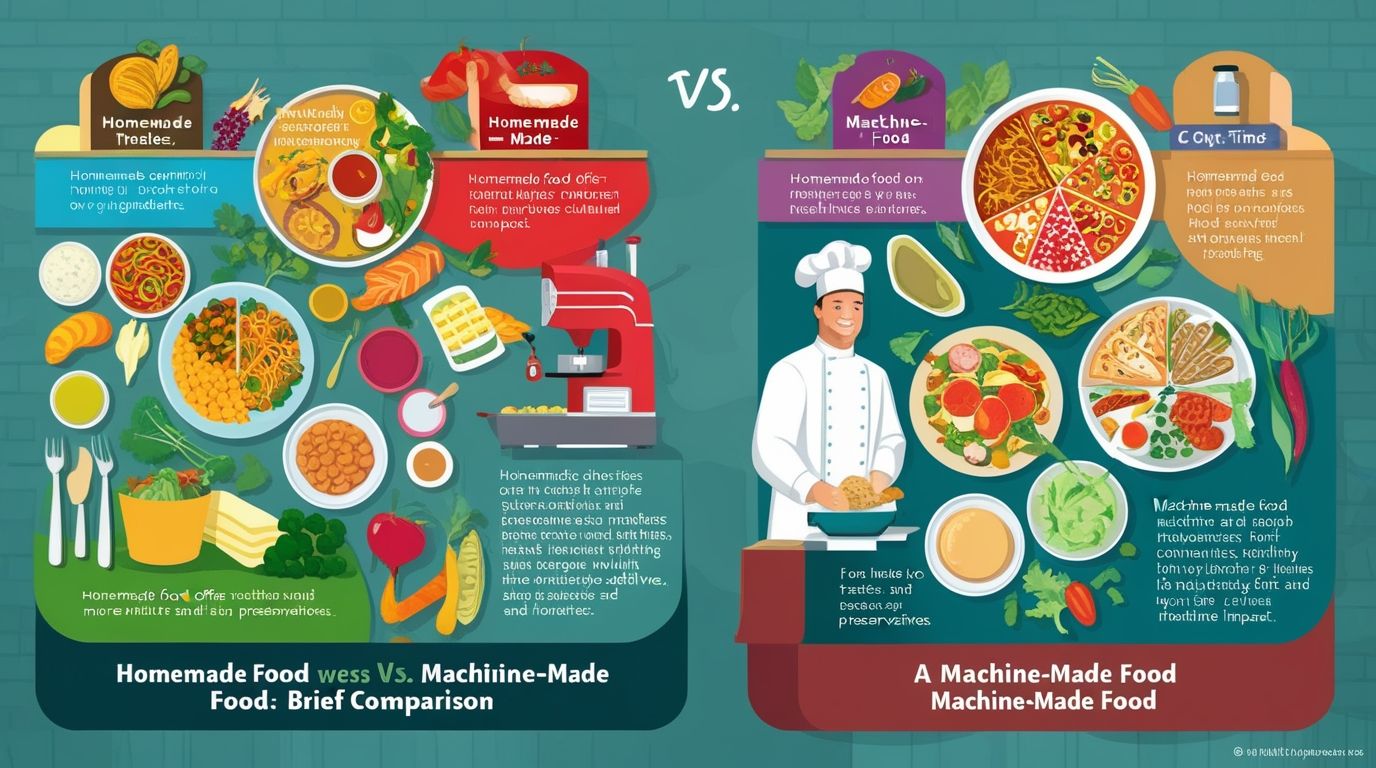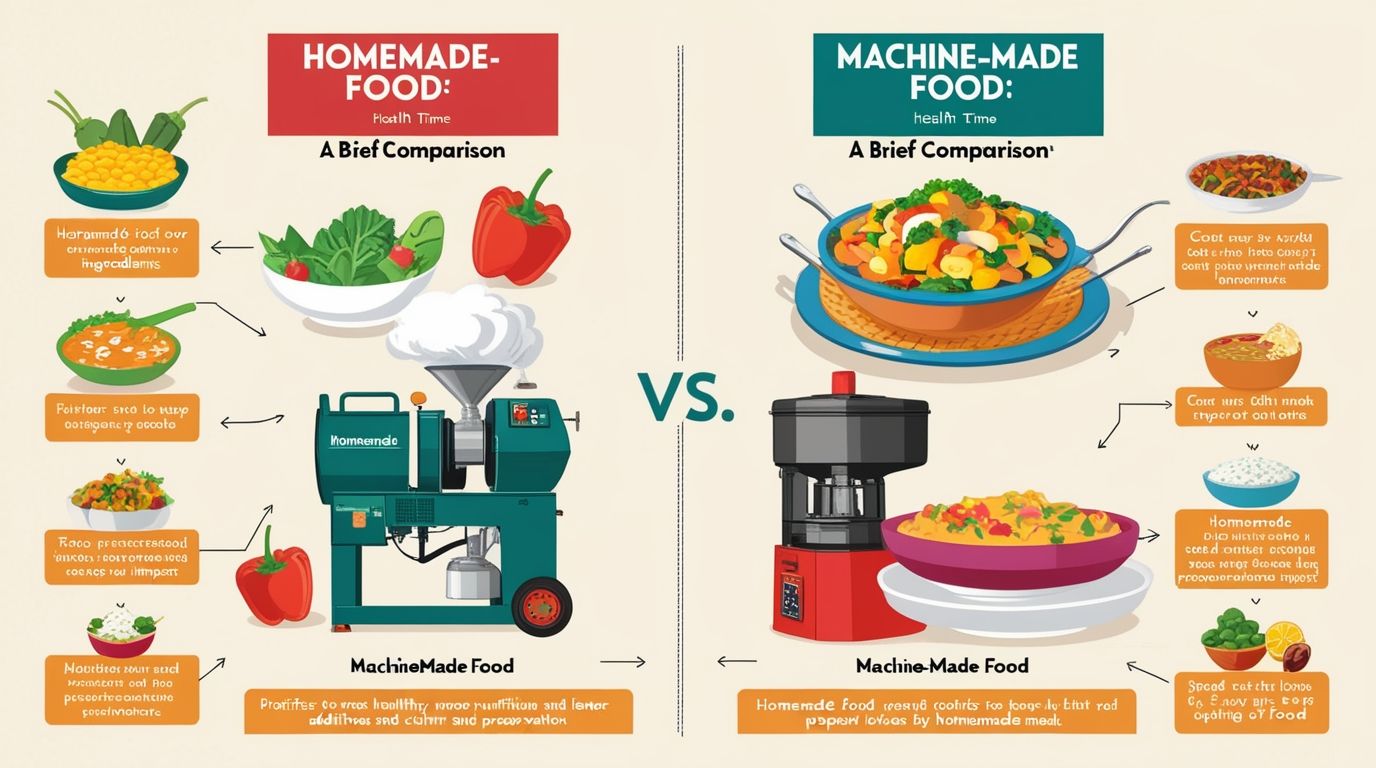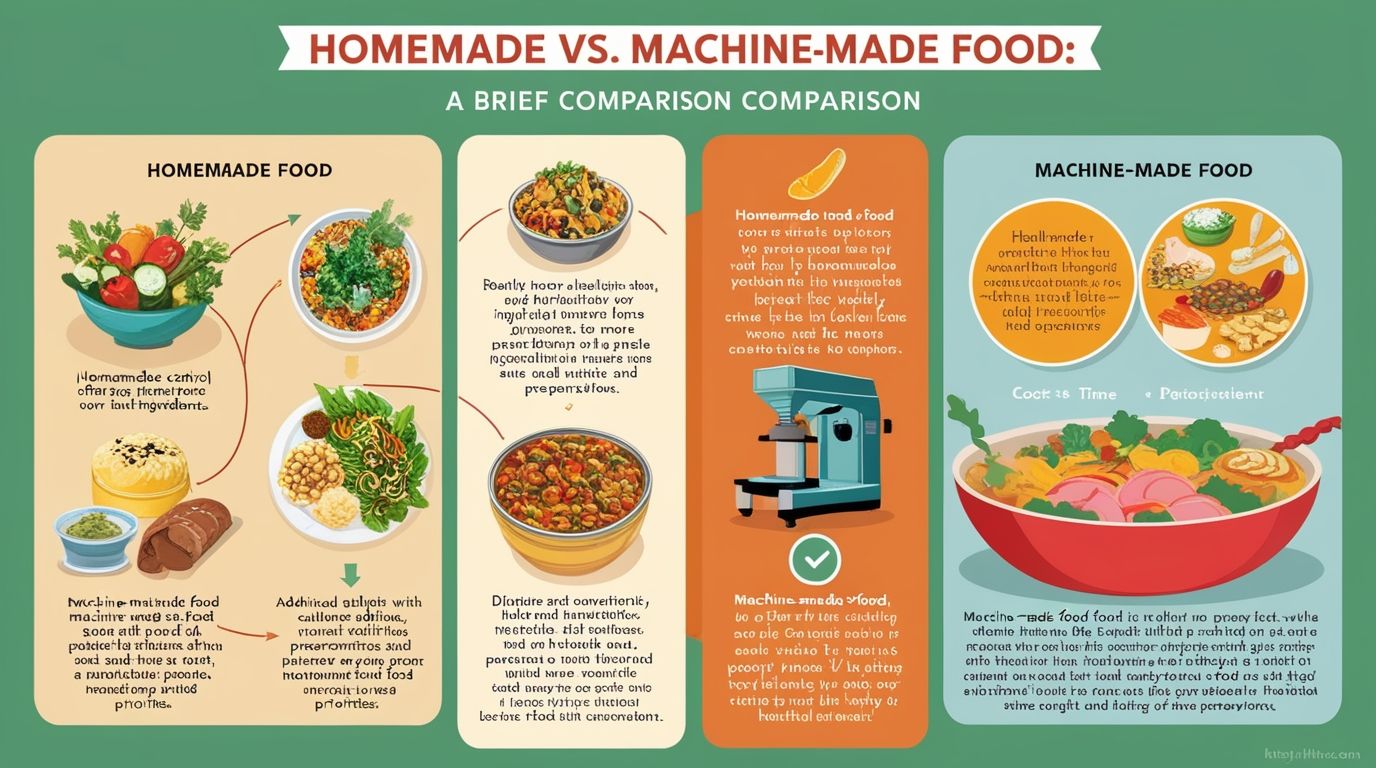Homemade vs. Machine-made Food, The modern food industry has witnessed a significant transformation, driven by technological advancements and changing consumer preferences. One of the central debates in this evolving landscape is the comparison between homemade and machine-made food. Both have their unique attributes, benefits, and drawbacks, influencing consumer choices in terms of health, convenience, taste, and environmental impact. In this article, we will explore the nuances between homemade and machine-made food, focusing on their differences and how they impact our lives.
1. Health and Nutritional Value
Homemade Food
One of the strongest arguments in favor of homemade food is its superior health benefits. When food is prepared at home, the cook has complete control over the ingredients, ensuring that fresh, high-quality, and often organic items are used. Homemade food typically involves fewer preservatives, artificial additives, and processed ingredients, contributing to its nutritional value.
For instance, when you prepare a meal from scratch, you can control the amount of salt, sugar, and fats that go into it. This is especially important for individuals with specific dietary needs, such as those managing diabetes, hypertension, or food allergies. Moreover, homemade food allows for a more balanced diet, as it can include a wider variety of food groups, ensuring a proper intake of vitamins, minerals, and essential nutrients.
Machine-made Food
Machine-made or processed food, on the other hand, is often criticized for its lower nutritional value. Mass-produced food products frequently contain artificial preservatives, flavor enhancers, and high levels of salt, sugar, and unhealthy fats to enhance flavor, prolong shelf life, and improve texture. These additives may negatively impact health, contributing to issues such as obesity, cardiovascular disease, and diabetes.
However, it is important to note that not all machine-made food is inherently unhealthy. Some companies are making efforts to improve the nutritional quality of their products by reducing harmful additives and incorporating more natural ingredients. Additionally, modern machines are capable of preserving the nutrient content of certain foods, such as vegetables, through techniques like flash freezing or vacuum sealing. In these cases, machine-made food can offer a convenient alternative without significantly compromising nutritional value.

2. Taste and Quality
Homemade Food
Taste is often subjective, but many people argue that homemade food tastes better because it is made with care and personal attention. Homemade meals are customized to suit individual preferences, and the quality of ingredients used is typically higher. The process of preparing food at home also involves various cooking techniques—sautéing, roasting, baking, etc.—which bring out rich, complex flavors that machine-made food often lacks.
Moreover, homemade food allows for experimentation with recipes and ingredients, leading to unique flavors that are difficult to replicate in mass-produced items. The experience of eating a freshly prepared meal, with the aroma and warmth of food straight from the oven or stove, adds to the overall sensory satisfaction.
Machine-made Food
Machine-made food prioritizes consistency and convenience, often at the expense of taste and quality. Due to the use of preservatives and other additives, the flavor profile of many processed foods tends to be more uniform and sometimes less authentic. While this can appeal to consumers seeking predictable flavors, it may lack the depth and richness of homemade dishes.
That said, technological advancements in food production have enabled the creation of machine-made items that closely mimic the taste and texture of homemade food. Pre-packaged meal kits, ready-to-eat dishes, and frozen meals are increasingly being produced with higher-quality ingredients, offering a more flavorful experience than traditional processed foods.
3. Convenience and Time Efficiency
Homemade Food
One of the main drawbacks of homemade food is the time and effort it requires. In today’s fast-paced world, many people find it challenging to allocate the time needed for meal preparation, cooking, and cleanup. Depending on the complexity of the dish, cooking at home can take anywhere from 30 minutes to several hours, making it a less attractive option for individuals with busy schedules.
However, meal planning and batch cooking can mitigate some of these challenges. By preparing meals in advance, individuals can enjoy the benefits of homemade food without sacrificing too much time. Additionally, the sense of satisfaction and accomplishment that comes from cooking a meal from scratch can outweigh the time commitment for some people.
Machine-made Food
Machine-made food offers unparalleled convenience, making it an appealing option for those with limited time. Ready-to-eat meals, frozen foods, and snacks can be prepared in a matter of minutes, saving time for other activities. This convenience is particularly valuable in modern households, where both partners may work full-time and have little energy left for cooking after a long day.
Machine-made food is also a staple in settings like office break rooms, schools, and hospitals, where feeding a large number of people quickly and efficiently is important. In these contexts, the speed and ease of preparation provided by machine-made food are significant advantages.

4. Cost Considerations
Homemade Food
The cost of homemade food can vary widely depending on the ingredients used. In general, cooking at home is more cost-effective than eating out or purchasing pre-packaged meals. Basic ingredients like grains, vegetables, and proteins can be bought in bulk, reducing the overall cost per meal. Moreover, homemade food allows individuals to use leftovers and avoid the waste commonly associated with pre-packaged meals.
However, the initial cost of fresh, organic, or specialty ingredients can be higher than their processed counterparts. Additionally, kitchen equipment and utilities (like gas or electricity) contribute to the overall expense of homemade meals.
Machine-made Food
Machine-made food can either be more or less expensive than homemade food, depending on the specific product. Mass-produced items benefit from economies of scale, allowing manufacturers to sell them at lower prices. Processed foods, especially snacks and frozen meals, are often inexpensive, making them accessible to a wide range of consumers.
However, the cost of premium machine-made food products, such as organic or gourmet frozen meals, can be comparable to that of homemade food. Furthermore, the long-term health costs associated with consuming large amounts of processed food—such as medical bills for diet-related diseases—can offset the short-term savings.
5. Environmental Impact
Homemade Food
From an environmental perspective, homemade food is generally considered more sustainable. Preparing food at home typically involves fewer single-use plastic containers, less energy consumption for transportation and packaging, and minimal food waste, especially if leftovers are reused.
Additionally, consumers who prepare homemade meals often choose locally sourced, organic ingredients, further reducing their carbon footprint. By cooking in small batches, individuals can control portion sizes and minimize food waste, which is a significant issue in industrial food production.
Machine-made Food
Machine-made food, particularly heavily processed items, tends to have a larger environmental impact. The production, packaging, and transportation of mass-produced food contribute to greenhouse gas emissions, deforestation, and plastic waste. The use of single-use packaging, especially plastic, is a significant contributor to environmental degradation.
However, some manufacturers are making efforts to reduce their environmental footprint by adopting sustainable practices, such as using eco-friendly packaging and reducing energy consumption during production. Additionally, large-scale food production can sometimes be more efficient in terms of resource use than small-scale home cooking, especially when it comes to energy-intensive ingredients.
6. Cultural and Social Impact
Homemade Food
Food plays a central role in culture and social life, and homemade meals often carry deeper cultural significance. In many societies, cooking at home is seen as a way to preserve traditions, pass down family recipes, and foster a sense of community. The act of preparing and sharing a homemade meal can strengthen family bonds and create lasting memories.
In contrast, machine-made food lacks this cultural and social richness. While convenient, it often lacks the personal touch and emotional connection that comes with homemade meals.
Machine-made Food
Machine-made food, while convenient, may contribute to the erosion of culinary traditions. As people increasingly rely on pre-packaged meals and fast food, the knowledge and skills required for home cooking may decline. This shift could lead to a homogenization of diets, where traditional and regional dishes are replaced by standardized, mass-produced food.
However, machine-made food has also played a role in democratizing access to certain types of cuisine. For example, frozen meals and pre-packaged ingredients allow individuals to enjoy dishes from different cultures that they might not have the time or expertise to prepare from scratch.
Conclusion
In the debate between homemade and machine-made food, there is no clear winner, as both have their pros and cons. Homemade food excels in health, taste, and cultural significance but requires more time and effort. Machine-made food, on the other hand, offers convenience and consistency but may fall short in terms of nutrition and environmental sustainability.
Ultimately, the choice between homemade and machine-made food depends on individual priorities, such as health, time, cost, and personal values. By striking a balance between the two—incorporating homemade meals when possible and opting for healthier, eco-friendly machine-made options when necessary—consumers can enjoy the best of both worlds.
References:
- Monteiro, C. A., Moubarac, J.-C., Cannon, G., Ng, S. W., & Popkin, B. (2013). Ultra-processed products are becoming dominant in the global food system. Obesity Reviews, 14(S2), 21-28.
- Pollan, M. (2009). In Defense of Food: An Eater’s Manifesto. Penguin Press.
- Micha, R., Peñalvo, J. L., Cudhea, F., Imamura, F., Rehm, C. D., & Mozaffarian, D. (2017). Association between dietary factors and mortality from heart disease, stroke, and type 2 diabetes in the United States. JAMA,

7 thoughts on “Homemade vs. Machine-made Food”
Comments are closed.